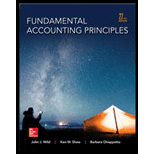
Concept Introduction:
Relevant or avoidable costs and Irrelevant or unavoidable costs –
The major decisions that a business has to take during its operations include elimination of segment, buy or make a product, to sell at scrap or rework on the product, to accept special offers etc. All these decisions are taken on the basis of the costs involved. There are two types of costs –
1. Relevant costs or avoidable costs – these costs can be defined as the costs that can be avoided if we choose over option over the other. Example of relevant costs are, direct material, direct labor, avoidable fixed costs etc.
2. Irrelevant costs – these costs can be defined as the costs that cannot be avoided in any of the options available or the costs which have been already incurred like sunk costs. Examples of irrelevant costs are unavoidable fixed costs, or the costs which have been already incurred
To determine:
Should the division be eliminated or not.
Want to see the full answer?
Check out a sample textbook solution
Chapter 25 Solutions
Fundamental Accounting Principles -Hardcover
- Not use ai solve this questions do fastarrow_forwardAssuming a 360-day year, the cash proceeds to Charleston Co. Arearrow_forwardComparative Income Statements and Basic EPS Anoka Company reported the following selected items in the shareholders' equity section of its balance sheet on December 31, Year 3, and Year 4: December 31 Year 4 Year 3 Preferred stock, 7%, 100 par, nonconvertible $50,000 $50,000 Common stock, $10 par 84,000 70,000 In addition, it listed the following selected pretax items as of December 31, Year 3 and Year 4: December 31, Year 4 December 31, Year 3 Debit Credit Debit Credit Sales $140,000 $124,300 Income from discontinued operations — 6,000 Cost of goods sold $80,000 $75,000 Operating expenses 20,000 18,000 Loss from discontinued operations 9,000 — The preferred shares were outstanding during all of Year 3 and Year 4; annual dividends were declared and paid in each year. During Year 3, 2,000 common shares were sold for cash on October 4. During Year 4, a 20% stock dividend was declared and issued in early May.…arrow_forward
- Kindly help me with this financial accounting questions not use chart gpt please fast given solutionarrow_forwardCan you explain the correct approach to solve this general accounting question?arrow_forwardThe standard materials cost to produce 1 unit of Product T is 6 pounds of material at a standard price of $38 per pound. In manufacturing 10,200 units, 50,500 pounds of material were used at a cost of $39 per pound. What is the total direct materials cost variance? A. $14,500 favorable B. $60,500 favorable C. $24,900 unfavorable D. $50,500 unfavorablearrow_forward

 AccountingAccountingISBN:9781337272094Author:WARREN, Carl S., Reeve, James M., Duchac, Jonathan E.Publisher:Cengage Learning,
AccountingAccountingISBN:9781337272094Author:WARREN, Carl S., Reeve, James M., Duchac, Jonathan E.Publisher:Cengage Learning, Accounting Information SystemsAccountingISBN:9781337619202Author:Hall, James A.Publisher:Cengage Learning,
Accounting Information SystemsAccountingISBN:9781337619202Author:Hall, James A.Publisher:Cengage Learning, Horngren's Cost Accounting: A Managerial Emphasis...AccountingISBN:9780134475585Author:Srikant M. Datar, Madhav V. RajanPublisher:PEARSON
Horngren's Cost Accounting: A Managerial Emphasis...AccountingISBN:9780134475585Author:Srikant M. Datar, Madhav V. RajanPublisher:PEARSON Intermediate AccountingAccountingISBN:9781259722660Author:J. David Spiceland, Mark W. Nelson, Wayne M ThomasPublisher:McGraw-Hill Education
Intermediate AccountingAccountingISBN:9781259722660Author:J. David Spiceland, Mark W. Nelson, Wayne M ThomasPublisher:McGraw-Hill Education Financial and Managerial AccountingAccountingISBN:9781259726705Author:John J Wild, Ken W. Shaw, Barbara Chiappetta Fundamental Accounting PrinciplesPublisher:McGraw-Hill Education
Financial and Managerial AccountingAccountingISBN:9781259726705Author:John J Wild, Ken W. Shaw, Barbara Chiappetta Fundamental Accounting PrinciplesPublisher:McGraw-Hill Education





